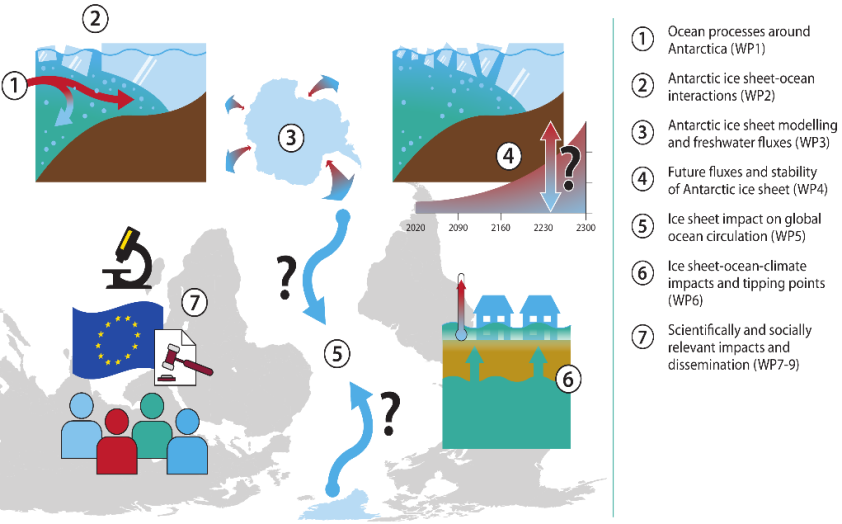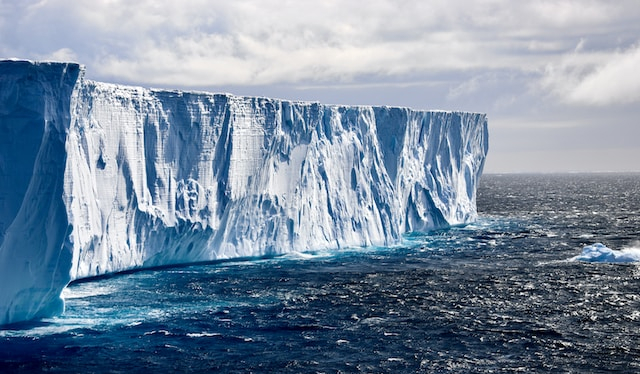About OCEAN ICE
Ocean-Cryosphere Exchanges in Antarctica: Impacts on Climate and the Earth System (OCEAN ICE) is a project funded by the European Union via the Horizon Europe programme and UKRI.
OCEAN ICE assess the impacts of key Antarctic Ice Sheet and Southern Ocean processes on Planet Earth, via their influence on sea level rise, deep water formation, ocean circulation and climate.
An innovative and ambitious combination of observations and numerical models, including coupled ice sheet-climate model development, will be used to improve predictions of how changes in the Antarctic and Greenland ice sheets impact global climate.
- We will make new circumpolar and Atlantic observations in observational gaps.
- We will assimilate these and existing data into improved ice sheet boundary conditions and forcing, producing new estimates of ice sheet melt and impacts on ocean circulation, including the Atlantic Meridional Overturning circulation.
- We will develop, calibrate and assess models used to predict the future evolution of the giant ice sheets.
- We will reduce the deep uncertainty in the impact of their melt on societally relevant environmental changes on decadal to multi-centennial time scales.
- We will assess the potential for passing ice sheet ‘tipping points’ and their consequences for ocean circulation and climate.
Specific OCEAN ICE Objectives
Objective 1
Reduce the spatial and knowledge gaps in ocean observations around Antarctica, particularly relating to ice sheet-ocean interaction and deep water formation and export. This will assess the oceanic controls on heat and freshwater delivery to and from ‘cold’ (e.g. Weddell Sea) as well as ‘warm’ (Amundsen Sea) sites of ice sheet-ocean interaction around Antarctica, and the processes that control mixing, water mass formation and export over the continental shelves and subpolar basins.
Objective 2
Improve critical ice sheet-ocean processes in numerical models, using historical observations and new data sets obtained in the project. Particularly under warm and cold ice shelves and around grounded icebergs, including vertical/horizontal mixing, ocean heat delivery, iceberg interactions with sea-ice and bathymetry and basal melt. Implement these improvements in coupled ice sheet-ocean and ice sheet-climate models.
Objective 3
Improve representation of AIS dynamics and integrate this knowledge into ice sheet and coupled ice sheet-climate models. By using new and existing datasets to improve ice sheet model initialisation and quantifying the uncertainty in present day freshwater fluxes from Antarctica due to climate variability, dynamical processes (calving, ice flow) and surface/basal mass balance (surface runoff, basal melt).
Objective 4
Quantify AIS melt sensitivity to climate forcing and reduce the ‘deep uncertainty’ in freshwater flux and SLR projections to 2300. By combining newly developed coupled ice sheet-ocean models with innovative quantification of uncertainty and improved initialisation setups. This will produce projections of the contributions by basal meltwater, iceberg calving and surface runoff for a range of future climate scenarios, including tipping points.
Objective 5
Assess how global ocean circulation is impacted by freshwater discharge from the northern and southern ice sheets. Map the pathways and variability of Antarctic Bottom Water as it spreads north. Assess how this and other freshwater input modifies climatically relevant ocean features such as North Atlantic Deep Water formation, the deep overturning circulation, the Antarctic Circumpolar Current (ACC) and AMOC up to millennial timescales.
Objective 6
Assess the ocean impact on, and feedbacks between, key global climate metrics (e.g. SLR, global mean surface temperature) and polar ice sheet melt to 2300 and beyond. This will be achieved by combining the improved melt scenarios, initialisation and model parameterisations, notably the representation of icebergs and ice shelf processes, within coupled ice sheet-climate models. It will establish the impact and likelihood of ice sheet melt scenarios, including passing tipping points, and global consequences such as SRL and AMOC state change.
Objective 7
Deliver free and open access to all data obtained in the project and contribute to international assessments (e.g. IPCC), climate model development, multi-national ocean observing initiatives (e.g. SOOS, All-Atlantic Ocean Research Alliance) and policymakers. Data consolidation and delivery will be achieved through close integration with SOOS, EMODnet and Copernicus data delivery services and will follow FAIR principles and be INSPIRE compliant. Direct partnership with SOOS, SAMOC, EPB, EU Polar Cluster, EU-Polarnet 2, and other European and international programmes, as well as the high-level involvement of investigators in international science coordination, climate assessment and policy bodies will maximise the reach and impact of OCEAN ICE.









